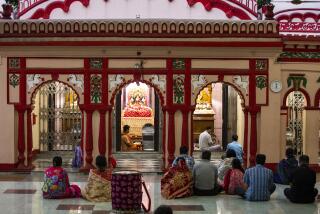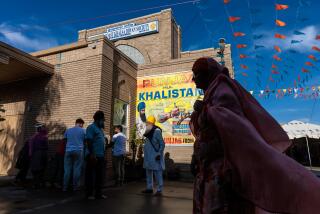Sikhs Dominate Punjab : Hindus: A Forgotten Minority
- Share via
BANGA, India — For Sucha Ram, the last year or so has been a time of sadness. He is a musician, and since the army raided the Sikhs’ Golden Temple, touching off months of violence, Punjab has been tense and unhappy. There has been very little merry-making.
Ram, 25, plays harmonium and horn in the Laxmi Brass Band, which customarily performs at wedding parties in this rich farming community. He told a visitor: “There were many marriages, but we could not go to them. The people married quietly.”
Sarwan Ram, 54, the proprietor of a provisions shop on Banga’s main street, complained that the curfew and security patrols have forced him to shut down for weeks at a time.
‘Had to Starve’
And Pukhran Parshad, 71, a beggar in saffron jersey and navy-blue athletic shoes, said, “The whole country was troubled.” He tilted his aluminum begging bucket to reveal his sparse day’s take and added: “When I could not beg, I had no food. I had to starve for many days.”
All three are Hindus in a state where there is a Sikh majority. They are among the 7 million Hindus who have been almost forgotten in the swirl of attention focused on the state’s 8 million Sikhs.
The sensational events of recent months that followed the June, 1984, raid on the Golden Temple in Amritsar, the Sikhs’ holiest shrine, have left an impression that the “Punjab problem” is an altogether Sikh problem.
After the raid, there was the assassination of Prime Minister Indira Gandhi by two Sikh guards, the slaughter of Sikhs by Hindu mobs in New Delhi and other cities and the crash of an Air-India jetliner into the Atlantic, which is widely believed to have been the work of Sikh terrorists.
Richest Farming State
Throughout those months, Punjab, India’s richest agricultural state, appeared to be the exclusive domain of the swaggering, bearded and turbaned khalsa , or pure, Sikhs. The Sikhs have always seemed to be greater than their number. Sikh men tend to be larger than other Indian men, and they are all named Singh, which means “lion.” The women are called Kaur, which means “princess” or “lioness.”
Historically, though, the Hindus have a stronger claim to the fertile Punjab plain than do the Sikhs, who only in the last 40 years have become the majority here. And the Sikhs have only a bare majority in what is now the state of Punjab, a fraction of the territory that was known as the Punjab in the time of the British Empire.
The Punjab has twice been divided, and it is now four separate entities. The first division, at the time of the bloody partition of India and Pakistan in 1947, sliced the Punjab down the middle, the west going to the new country of Pakistan and the east to India. In 1966, under pressure from Sikh militants seeking a majority Sikh state, the Indian part was divided into three states--Haryana, Himachal Pradesh and Punjab.
Divided Community
The Sikhs found that even as the majority, they were unable to control the affairs of the state of Punjab, because of the still-sizable Hindu population and divisions within the Sikh community. Thus, there developed a Sikh separatist movement--for a nation to be known as Khalistan, or Sikhistan--and this gave rise to confrontation between Sikh and Hindu.
After much violence, an agreement was reached last week between Harchand Singh Longowal, leader of the Sikh Akali Dal party, and Prime Minister Rajiv Gandhi. It will give to Punjab the city of Chandigarh, which has been the capital of both Haryana and Punjab, and transfer some Hindu areas of Punjab to Haryana, a majority-Hindu state. And it will further concentrate the Sikh population in Punjab.
The Hindu community in Punjab has protested the dilution of its population and its loss of participation in state affairs, but it has been all but drowned out by the more vociferous and better-organized Sikh militants. Still, resentment over the “Sikhification” of Punjab runs deep, particularly in the cities and towns, which are predominantly Hindu.
‘Problem Is Greediness’
Sarwan Ram, the Banga shopkeeper whose family goes back for generations in Punjab, said: “The problem is the greediness of the people. They want this and they want that, and now they want some more. Before, Punjab was a very big state; in 1966 it became smaller. If these demands (for a separate state) are granted, it will disappear altogether.”
From the outset of the Sikh separatist movement, the Hindu population has based its hope for survival on the historically close connection between Sikhs and Hindus.
Since the Mogul Empire of the 17th Century, many Hindu families have given their eldest son to Sikh priests to be trained in martial arts in the expectation that he would come back and protect the family. Sikhs have always been free to worship in Hindu temples and Hindus in Sikh gurdwaras.
Prof. Paranjit Nayar, a Hindu and head of the physics department at the Sikh National College in Banga, says his father was a Sikh. Most of his students at the college, which is affiliated with the Sikh religion, are Sikhs. Like other Hindus, Nayar attempts to minimize the differences between Sikhs and Hindus.
“There was no communalism between Hindus and Sikhs until a few years ago,” he told a visitor. “If you look at it like Christianity, Hindus are just like the Protestants and Sikhs are just like Catholics.”
Actually, the Christian analogy works better with the Sikhs as Protestants, since the 485-year-old faith was founded in large measure as a protest against the rigid caste prejudices of Hinduism.
Sucha Ram, the musician, said: “There is no difference between Hindus and Sikhs. But something happened in the brain that made them kill each other.”
Indeed, most modern Sikh historians contend that divisions between the two faiths are becoming greater. As more and more Sikhs become educated, there is increasing fear among fundamentalist Sikhs, who form the backbone of the separatist movement, that Sikhism will be absorbed by Hinduism.
Campaign Against Hindus
By the most liberal estimates, Sikhs make up no more than 60% of Punjab’s population. So, in order to justify a separate Sikh state, Sikh radicals have campaigned to drive Hindus out of the Punjab and to incite Hindu violence against the 3 million to 5 million Sikhs outside Punjab in the hope of luring them back.
There are Sikhs living in every Indian state. Sikhs have prosperous farming communities in Haryana and in Uttar Pradesh, a Hindu stronghold that is the most populous Indian state. The Sikh community in New Delhi, the national capital, is thought to be a million strong.
After the assassination of Indira Gandhi last October, the violence against Sikhs living outside Punjab drove several thousand of them into Punjab as refugees. In Banga, a town of about 10,000, there are roughly 100 refugees from the state of Bihar, where many incidents of anti-Sikh violence took place.
Family Killed by Mobs
Tirlok Singh, 62, left Bihar with his family after two nephews were killed by Hindu mobs. Singh owned farmland there, and his nephews worked on construction projects. He still refers to Bihar as his home.
“If things were peaceful, I would like to go back,” he said. “Those who had something left to go back to have gone back.”
According to some experts, the number of Hindus in Punjab may actually be greater than census figures indicate. They say this is so because of Punjab’s prosperity. The so-called Green Revolution in wheat and other grains, spurred by U.S. aid, has multiplied harvests sixfold. Per-capita income in Punjab is more than double what it is in the rest of India.
The prosperity affects population in two ways. It finances foreign trips and education for young Sikh males, several hundred thousand of whom have emigrated to the United States, Canada and Europe. And it attracts impoverished Hindus from other states seeking work in Punjab’s fields and factories.
Hari Das Kushwaha, 35, came to Banga eight years ago along with other poor Hindus from Madhya Pradesh, a spectacularly poor state in central India. Now, he and about 150 other former Madhya Pradeshans make a living out of old jute sacks, which they carefully repair with needle and thread and sell to farmers. A large sack, Kushwaha said, sells for three rupees, about 25 cents.
Kushwaha admitted that his business has suffered somewhat because of the troubles. And he added, “They gave us a few slaps if they caught us out after curfew.”
But to him and thousands of other poor Hindus who have migrated here in search of work, the dangers of the Sikh conflict are preferable to the misery they left behind.
Pleased With Accord
For the time being at least, most of the Punjab’s Hindus seem to be happy that the Indian government has reached an accord with the Sikh political leaders.
“That is a good agreement,” Prof. Nayar said. “It has brought peace to the country and has been welcomed by the public. The agitation . . . is over.”
The musician, Ram, is hoping that peace will bring back the joyous weddings of old, along with work for the Laxmi Brass Band. Shopkeeper Ram hopes for better times, and Parshad, the beggar, looks ahead to more alms, though he says it will change him little.
“There will be peace now,” he said, smiling, “but I am always at peace.”
More to Read
Sign up for Essential California
The most important California stories and recommendations in your inbox every morning.
You may occasionally receive promotional content from the Los Angeles Times.










